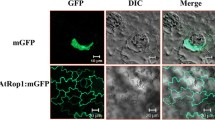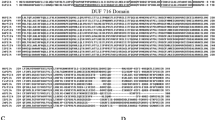Abstract
Medicarpin and maackiain are antifungal pterocarpan phytoalexins produced by many legumes, and are thought to be important components of the defense response of these legumes to certain fungal pathogens. The Mak1 gene from the fungal pathogen Nectria haematococca encodes an FAD-dependent mono-oxygenase, known to specifically hydroxylate the phytoalexins medicarpin and maackiain, converting them to less fungitoxic derivatives. Two binary vector constructs were made containing the coding regions from two fungal clones, a Mak1 cDNA (intronless) and a genomic (including three fungal introns) clone, regulated by an enhanced cauliflower mosaic virus 35S promoter. The constructs were introduced into tobacco to check for expression of active fungal enzyme in plant cells and for splicing of fungal introns. Leaves of tobacco plants transformed with the Mak1 cDNA construct readily metabolized infiltrated medicarpin to 1a-hydroxymedicarpin, indicating high levels of active enzyme. RT-PCR analysis of tobacco plants transformed with the Mak1 genomic construct indicated no processing of Mak1 introns, and no Mak1 activity was detected in these plants. When using plants containing the Mak1 cDNA construct, immunolocalization with a Mak1-specific antibody together with cellular fractionation indicated that Mak1 protein accumulated in the plant cytoplasm, associated with endoplasmic reticulum membranes; medicarpin biosynthetic enzymes have been localized to the same subcellular region. The Mak1 cDNA construct is therefore suitable for use in studies to selectively eliminate medicarpin accumulation to assess the relative importance of medicarpin in the antifungal defense mechanisms of alfalfa and other legumes.
Similar content being viewed by others
References
An, G. 1986. Development of plant promoter expression vectors and their use for analysis of differential activity of nopaline synthase promoter in transformed tobacco cells. Plant Physiol. 81: 86–91.
An, G., Edbert, P.R., Mitra, A. and Ha, S.B. 1988. Binary vectors.In: S.B. Gelvin, and R.A. Schilperoort (Eds.) Plant Molecular Biology Manual, Kluwer Academic Publishers, Dordrecht, Netherlands, pp. A3: 1–9.
Baek, J.-M., Howell, C.R. and Kenerley, C.M. 1999. The role of an extracellular chitinase from Trichoderma virens Gv29-8 in the biocontrol of Rhizoctonia solani. Curr. Genet. 35: 41–50.
Bell, J.N., Dixon, R.A., Bailey, J.A., Rowell, P.M. and Lamb, C.J. 1984. Differential induction of chalcone synthase mRNA activity at the onset of phytoalexin accumulation in compatible and incompatible plant-pathogen interactions [Phaseolus vulgaris, Colletotrichum lindemuthianum]. Proc. Natl. Acad. Sci. USA 81: 3384–3388.
Blount, J.W., Dixon, R.A. and Paiva, N.L. 1993. Stress responses in alfalfa (Medicago sativa L.). XVI. Antifungal activity of medicarpin and its biosynthetic precursors; implications for the genetic manipulation of stress metabolites. Physiol. Mol. Plant. Path. 41: 333–349.
Buchanan, B.B., Gruissem, W. and Jones, R.L. (Eds.). 2000. Bio-chemistry & Molecular Biology of Plants. American Society of Plant Physiologists, Rockville, MD, 1367 pp.
Church, G.M. and Gilbert, W. 1984. Genomic sequencing. Proc.Natl. Acad. Sci. USA 81: 1991–1995.
Covert, S.F., Enkerli, J., Miao, V.P.W. and VanEtten, H.D. 1996. A gene for maackiain detoxification from a dispensable chromo-some of Nectria haematococca. Mol. Gen. Genet. 251: 397–406.
Denny, T.P. and VanEtten, H.D. 1982. Metabolism of the phytoalexins medicarpin and maackiain by Fusarium solani. Phytochem-istry21: 1023–1028.
Dewick, P.M. 1988. Isoflavonoids. In: J.B. Harborne (Ed.) The Flavonoids: Advances in Research since 1980, Chapman and Hall, New York, pp.125–209.
Dixon, R.A., Choundhary, A.D., Dalkin, K., Edwards, R., Fahrendorf, T., Gowri, G., Harrison, M.J., Lamb, C.J., Loake, G.J., Maxwell, C.A., Orr, J. and Paiva, N.L. 1992. Molecular biology of stress-induced phenylpropanoid and isoflavonoid biosynthesis in alfalfa. In: H.A. Stafford and R.K. Ibrahim (Eds.) Phenolic Metabolism in Plants, Vol. 26, Plenum Press, New York, pp. 91–138.
Eckenrode, V.K., Arnold, J. and Meagher, R.B. 1985. Comparison of the nucleotide sequence of soybean 18S rRNA with the sequences of other small-subunit rRNAs. J. Mol. Evol. 21: 259–269.
Gaffney, T., Friedrich, L., Vernooij, B., Negrotto, D., Nye, G., Uknes, S., Ward, E., Kessmann, H. and Ryals, J. 1993. Requirement of salicylic acid for the induction of systemic acquired resistance.Science 261: 754–756.
Giczey, G., Kerenyi, Z., Dallmann, G. and Hornok, L. 1998. Homologous transformation of Trichoderma hamatum with an endochitinase encoding gene, resulting in increased levels of chitinase activity. FEMS Microbiol. Lett. 165: 247–52.
Goodall, G.J. and Filipowicz, W. 1989. The AU-rich sequences present in the introns of plant nuclear pre-mRNAs are required for splicing. Cell 58: 473–483.
Goodall, G.J. and Filipowicz, W. 1990. The minimum functional length of pre-mRNA introns in monocots and dicots. Plant Mol. Biol. 14: 727–733.432
Goodall, G.J. and Filipowicz, W. 1991. Different effects of intron nucleotide composition and secondary structure on pre-mRNA splicing in monocot and dicot plants. EMBO J. 10: 2635–2644.
Guo, L. and Paiva, N.L. 1995. Molecular cloning and expression of alfalfa (Medicago sativa L.) vestitone reductase, the penultimate enzyme in medicarpin biosynthesis. Arch. Biochem. Biophys. 320: 353–360.
Higgins, V.J. 1972. Role of the phytoalexin medicarpin in three leaf spot diseases of alfalfa [Stemphylium botryosum, Phoma herbarum medicaginis, Leptosphaerulina briosiana]. Physiol. Plant Path. 2: 289–300.
Hohl, B., Arnemann, M. and Schwenen, L. 1989. Degradation of the pterocarpan phytoalexins (-)-maackiain by Ascochyta rabei. Z. Naturforsch. Sect. C Biosci. 44: 771–776.
Hohn, T.M. and Ohlrogge, J.B. 1991. Expression of a fungal sesquiterpene cyclase gene in transgenic tobacco. Plant Physiol. 97: 460–462.
Horsch, R.B., Joyce, F., Hoffman, N., Neidermeyer, J., Rogers, S.G. and Fraley, R.T. 1988. Leaf disc transformation. In: S.B. Gelvin, and R.A. Schilperoort (Eds.) Plant Molecular Biology Manual,Kluwer Academic Publishers, Dordrecht, Netherlands, pp. A5:1–9.
Joost, O., Bianchini, G., Bell, A.A., Benedict, C.R. and Magill, C.W. 1995. Differential induction of 3-hydroxy-3-methylglutaryl CoA reductase in two cotton species following inoculation with Verticillium. Mol. Plant-Microbe Interact. 8: 880–885.
Klein, P., Kanehisa, M. and DeLisi, C. 1985.The detection and classification of membrane-spanning proteins. Biochim. Biophys. Acta. 815: 468–476.
Koegel, R.G., Straub, R.J., Austin-Phillips, S., Cook, M.E. and Crenshaw, T.D. 1999. Alfalfa-produced phytase for supplemen-tation of poultry and swine rations. ASAE-CSAE-SCGR Annual International Meeting, Toronto, Ontario, Canada, ASAE Paper 996127.
Kyte, J. and Doolittle, R.F. 1982. A simple method for displaying the hydropathic character of a protein. J. Mol. Biol. 157: 105–132.
Koziel, M.G., Carozzi, N.B. and Desai, N. 1996. Optimizing expression of transgenes with an emphasis on post-transcriptional events. Plant Mol. Biol. 32: 393–405.
Latunde-Dada, A.O., Dixon, R.A. and Lucas, J.A. 1987. Induction of phytoalexin biosynthetic enzymes in resistant and susceptible lucerne callus lines infected with Verticillium albo-atrum. Physiol. Mol. Plant Path. 31: 15–23.
Lawton, K., Weymann, K., Friedrich, L., Vernooij, B., Uknes, S. and Ryals, J. 1995. Systemic acquired resistance in Arabidopsis requires salicylic acid but not ethylene. Mol. Plant-Microbe Interact. 8: 863–870.
Lorito, M., Woo, S.L., Fernandez, I.G., Colucci, G., Harman, G.E., Pintor-Toro, J.A., Muccifora, S., Lawrence, C.B., Zoina, A., Tuzun, S. and Scala, F. 1998. Genes from mycoparasitic fungi as a source for improving plant resistance to fungal pathogens. Proc. Natl. Acad. Sci. USA 95: 7860–7865.
Mansfield, J.W. and Bailey, J.A. 1982. Phytoalexins: current problems and future prospects. In: J.A. Bailey and J.W. Mansfield (Eds.) Phytoalexins, Halsted, New York, pp. 81–105.
Murashige, T. and Skoog, F. 1962. A revised media for rapid growth and bioassay with tobacco tissue culture. Physiol. Plant 15: 473–497.
Oommen, A., Dixon, R. and Paiva, N.L. 1994. The elicitor-inducible alfalfa isoflavone reductase promoter confers different patterns of developmental expression in homologous and heterologous transgenic plants. Plant Cell 6: 1789–1803.
Paiva, N.L. 2000. An introduction to the biosynthesis of chemicals used in plant-microbe communication. J. Plant Growth Regul.19: 131–143.
Paiva, N.L., Edwards, R., Sun, Y., Hrazdina, G. and Dixon, R.A. 1991. Stress responses in alfalfa (Medicago sativa L.). XI. Molecular cloning and expression of alfalfa isoflavone reductase, a key enzyme of isoflavonoid phytoalexin biosynthesis. Plant Mol. Biol. 17: 653–667.
Paiva, N.L., Oommen, A., Harrison, M.J. and Dixon, R.A. 1994. Regulation of isoflavonoid metabolism in alfalfa. Plant Cell Tissue Organ Cult. 38: 213–220.
Rasmussen, S. and Dixon, R.A. 1999. Transgene-mediated and elicitor-induced perturbation of metabolic channeling at the entry point into the phenylpropanoid pathway. Plant Cell 11: 1537–1551.
Restrepo, M.A., Freed, D.D. and Carrington, J.C. 1990. Nuclear transport of plant potyviral proteins. Plant Cell 2: 987–988.
Ryals, J., Lawton, K.A., Delaney, T.P., Friedrich, L., Kessmann, H., Neuenschwander, U., Uknes, S., Vernooij, B. and Weymann, K. 1995. Signal transduction in systemic acquired resistance. Proc. Natl. Acad. Sci. USA 92: 4202–4205.
Sambrook, J., Fritsch, E.F. and Maniatis, T. 1989. Molecular Cloning: A Laboratory Manual, 2nd ed. Cold Spring Harbor Laboratory Press, Plainview, NY.
Schroeder, M.R., Borkhsenious, O.N., Matsuoka, K., Nakamura, K. and Raikhel, N.V. 1993. Colocalization of barley lectin and sporamin in vacuoles of transgenic tobacco plants. Plant Physiol. 101: 451–458.
Simpson, G.G. and Filipowicz, W. 1996. Splicing of precursors to mRNA in higher plants: mechanism, regulation and sub-nuclear organization of the spliceosomal machinery. Plant Mol. Biol. 32: 1–41.
Soby, S., Caldera, S., Bates, R. and VanEtten, H. 1996. Detoxification of the phytoalexins maackiain and medicarpin by fungal pathogens of alfalfa. Phytochemistry 41: 759–765.
Tenhaken, R., Salmen, H.C. and Barz, W. 1991. Purification and characterization of pterocarpan hydroxylase, a flavoprotein monooxygenase from the fungus Ascochyta rabiei involved in pterocarpan phytoalexin metabolism. Arch. Microbiol. 155: 353–359.
VanEtten, H.D., Matthews, D.E. and Smith, D.A. 1982. Metabolism of phytoalexins. In: J.A. Bailey and J.W. Mansfield (Eds.) Phytoalexins, Halsted, New York, pp. 81–105.
VanEtten, H.D., Matthews, D.E. and Matthews, P.S. 1989. Phytoalexin detoxification: importance for pathogenicity and practical implications. Annu. Rev. Phytopath. 27: 143–164.
Vernooij, B., Uknes, S., Ward, E. and Ryals, J. 1994. Salicylic acid as a signal molecule in plant-pathogen interactions. Curr. Opin. Cell Biol. 6: 275–279.
Weigand, F., Koster, J., Weltzien, H.C. and Barz, W. 1986. Accumulation of phytoalexins and isoflavone glucosides in a resistant and a susceptible cultivar of Cicer arietinum during infection with Ascochyta rabiei. J. Phytopath. 115: 214–221.
You, I.S., Debabrota, G. and Gunsalus, I.C. 1991. Nucleotide sequence analysis of the Pseudomonas putida PpG7 salicylate hydroxylase gene (nahG) and its 3-flanking region. Biochemistry 30: 1635–1641.
Author information
Authors and Affiliations
Rights and permissions
About this article
Cite this article
Mundodi, S.R., Watson, B.S., Lopez-Meyer, M. et al. Functional expression and subcellular localization of the Nectria haematococca Mak1 phytoalexin detoxification enzyme in transgenic tobacco. Plant Mol Biol 46, 421–432 (2001). https://doi.org/10.1023/A:1010618606776
Issue Date:
DOI: https://doi.org/10.1023/A:1010618606776




